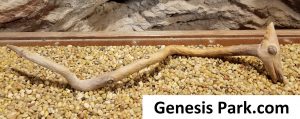The Indian Thunderbird
 The Thunderbird story as told by the western American Indians has become one of the most famous icons of their culture. Celebrated as having spiritual powers, this huge flying creature was understood differently by various native American tribes. For some, it took on mythological status and was fancifully depicted on totem poles. For others, it was a more sober part of their tribal histories. The Anasazi Prayer Stick pictured above is part of the collection at the Cliff Dwellings Museum in Manitou Springs, CO. It is roughly a foot long, with large eyes on the side and a long beak. The headcrest has a jagged posterior edge like that of the pterosaur called Thalassodromeus. Just this last month, Genesis Park was able to obtain a high-quality image of this beautiful artifact.
The Thunderbird story as told by the western American Indians has become one of the most famous icons of their culture. Celebrated as having spiritual powers, this huge flying creature was understood differently by various native American tribes. For some, it took on mythological status and was fancifully depicted on totem poles. For others, it was a more sober part of their tribal histories. The Anasazi Prayer Stick pictured above is part of the collection at the Cliff Dwellings Museum in Manitou Springs, CO. It is roughly a foot long, with large eyes on the side and a long beak. The headcrest has a jagged posterior edge like that of the pterosaur called Thalassodromeus. Just this last month, Genesis Park was able to obtain a high-quality image of this beautiful artifact.
On April 26, 1890 the Tombstone Epitaph (a local Arizona newspaper) reported that two cowboys had discovered and shot down a creature – described as a “winged dragon” – which resembled a pterodactyl, only MUCH larger. Could that have been a Thunderbird? To the north, the Sioux told stories of the Wakinyan, a jagged-winged, fierce-toothed flying creature. It supposedly lived in a cave on the top of a mountain and ate seafood. Bigger than the eagle (Wanbli) or hawk (Cetan) the Wakinyan was named because of its association with thunder and lightning. It supposedly was even being struck by lightning and seen to fall to the ground during a storm. (Geis, Darlene, Dinosaurs & Other Prehistoric Animals, 1959, p. 9.)
Posted on September 3, 2018 by dwoetzel.
